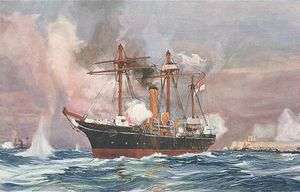Condor-class gunvessel
The Condor-class gunvessel was a class of four Royal Navy composite gunvessels of 3 guns, built between 1876 and 1877.[2] They were all hulked or sold before 1893, giving them an active life of less than 15 years.
 "Well Done Condor". Bombardment of Alexandria, 1882 by Charles Dixon | |
| Class overview | |
|---|---|
| Name: | Condor-class gunvessels |
| Builders: |
|
| Operators: |
|
| Built: | 1876–1877 |
| In commission: | 1877–1923 |
| Completed: | 4 |
| General characteristics | |
| Displacement: | 774 tons |
| Length: | 157 ft (48 m) |
| Beam: | 29 ft 6 in (8.99 m) |
| Draught: | 12 ft (3.7 m)[1] |
| Installed power: | Designed 750 ihp (560 kW) |
| Propulsion: |
|
| Sail plan: | Barque-rigged |
| Speed: | 11.5 kn (21.3 km/h) under power |
| Complement: | 100[1] |
| Armament: |
|
Construction
Design
Designed by Nathaniel Barnaby,[1] the Royal Navy Director of Naval Construction, the hull was of composite construction; that is, iron keel, frames, stem and stern posts with wooden planking.
Propulsion
They were fitted with three boilers, a 2-cylinder horizontal compound expansion steam engine and a single screw. Griffon and Falcon were engined by Laird Brothers and had a feathering propeller. Flamingo and Condor were engined by John Elder & Co, and all ships had a designed 750 indicated horsepower (560 kW), developing about 11.5 knots (21.3 km/h) under power.[1]
Sail plan
The class was rigged with three masts, with square rig on the fore- and main-masts, making them barque-rigged vessels.[1]
Armament
The ships of the class were fitted with a 7-in (4½-ton) muzzle-loading rifle and two 64-pounder (64cwt) muzzle-loading rifles, except for Flamingo, which had two 20-pounder breech-loaders in place of one of the 64-pounder muzzle-loading rifles. In 1884 Flamingo and Griffon were rearmed with two 5-in Vavasseur breech loaders replacing the 7-in muzzle-loading rifle.[1]
.jpg)
Ships
| Name | Ship Builder | Launched | Fate |
|---|---|---|---|
| Flamingo | Devonport Dockyard | 13 December 1876 | Hulk 1893. Sold to Plymouth Port Sanitary Authority on 25 May 1923. Sold on 4 May 1931 for breaking |
| Griffon | Laird Brothers, Birkenhead | 16 December 1876 | Sold to the Board of Trade as a hulk on 28 September 1891 and renamed Richmond |
| Condor | Devonport Dockyard | 28 December 1876 | Sold to George Cohen in August 1889 |
| Falcon | Laird Brothers, Birkenhead | 4 January 1877 | Hulk in 1890. Sold to E W Payne & Company on 25 June 1920 |
References
- Colledge, J. J.; Warlow, Ben (2006) [1969]. Ships of the Royal Navy: The Complete Record of all Fighting Ships of the Royal Navy (Rev. ed.). London: Chatham Publishing. ISBN 978-1-86176-281-8.
- Winfield, R.; Lyon, D. (2004). The Sail and Steam Navy List: All the Ships of the Royal Navy 1815–1889. London: Chatham Publishing. ISBN 978-1-86176-032-6.
- "Condor class gunvessels at battleships-cruisers website". Retrieved 9 February 2010.
External links
| Wikimedia Commons has media related to Condor class gunvessel. |